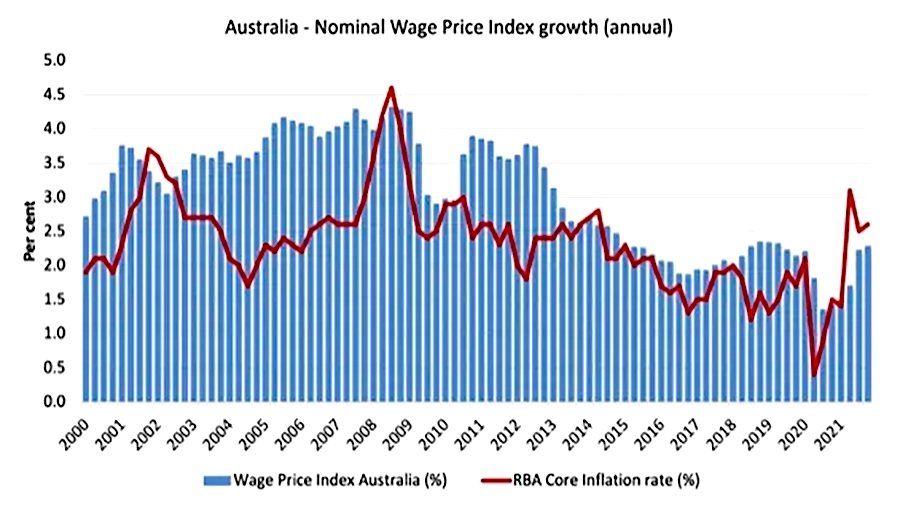Contributed by Joe Montero
The failure of wages to keep up and rising inflationary pressure on the Australian economy is going to push real wages further back. Philip Lowe, the governor of the Reserve Bank has warned that Australians will experience a wage cut of 1.5 percent this year.
Everyone knows that the wages share has been slipping for some years. Fewer know why this is happening. Put simply, this is the result of a sluggish economy, in which major employers have the power to redistribute the wealth we all create together, and they have been doing this to pass on the cost of falling returns on investment.
The graph from the Reserve Bank shown below reveals a long-term fall in wage growth relative to price rises. Note that the was some improvement in 2020 due to the Covid government subsidies. These were phased out in 2021 and the previous trend continued. If the price rises were factored into the wages, the fall would show to be even steeper.

One favoured technique to exercise this power is to turn secure jobs into insecure ones. If they can impose an effective pay cut on insecure workers, this percolates to reduce all wages. So, the explosion in insecure and part time work has been a major factor in the redistribution od Australia’s national income.
A government that cares about the wellbeing of the majority would do something about this. It could support wage increases and impose some restrictions on employers. There is another reason other than generosity to do this. Pulling down the wages share harm the economy.
When investment concentrates on cheapening those employed, attention is turned away from investment in innovation and creating what we consume. Only through creating new wealth can a sluggish economy turn into a healthy one. Redistribution of what already exists doesn’t do this.
Removing the punitive legal restrictions that prevent unions from properly defending their members would do a lot to address the balance of power weighted against workers.
But our government won’t do any of this because it depends on those who have the power in the economy to keep it in office.
Blame for the fall in real wages is being increasingly blamed on inflation caused by war in Ukraine. This is a furphy. There will be a short-term spike. But this does not explain the trajectory that have been with us from well before this phase of the conflict began.
The graph from the International Business Daily shown below reveals that as Covid hit Australia the cost of living started to climb.

In any case, why is Australia still tied to global oil prices, when we have our own independent supply? Removing this tie would answer the war’s inflationary pressure, caused mainly through the rise in oil prices.
The way inflation is measured understates the real situation. We all know that the price of everything has been going up even when we are told there is almost no inflation. The worst of all has been the cost of housing. Why has this been happening?
The growth of finance has been out of proportion to the rest of the economy, turning it into a bankers’ paradise. No other sector has been doing as well as the banks. They have been cashing in on speculative bubbles and doing even better through the creation of debt. Australia’s per capita private debt is the highest in the world. This bonanza for a few provides little incentive to encourage investment in the bread-and-butter stuff of our economy.
Official figures show that investment in what meters most is low in comparison and falling over the long-term. But what has this got to do with wages? It has a lot to do with it. Failure to invest in the real economy means the loss of jobs and the rise in unemployment and underemployment, and therefore a downward pressure on wages. Inflation mean that the real wage decreases as the dollars in pockets buy less and less.
There is a way around this. Controls to regulate finance and ensure that it is operating in the interests of Australia can be imposed. This would mean landing institutions would face barriers on how they use the money in their hands and inducements to use it appropriately.
The government could do one better by establishing a public banking sector. Create a national peoples bank that would set the standard for the treatment of customers. An infrastructure bank would specialise in providing funding for a balanced development of the economy, emphasising manufacturing based in the latest green technology, the revival of agriculture based on land care, and for the support of smaller businesses. Back this with an infrastructure bank to ensure investment in energy, power, transport, education and training, and other vital needs of a healthy economy.
This will lead to jobs and wages growth.


Be the first to comment on "Australia’s wages share set to fall even faster"